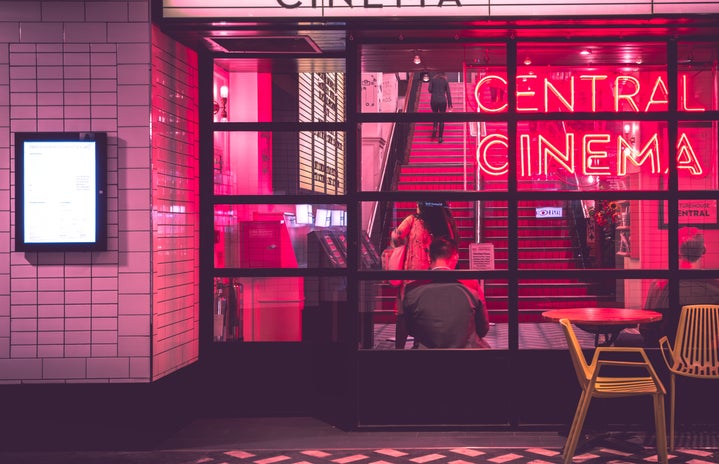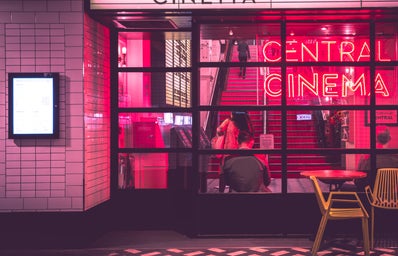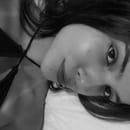Are you a lover of beautiful cinematography? A cinematic experience goes beyond plot and dialogue and the cinema girlies know it’s all about the details. If you’re one of those people, here are some suggestions for heart-warming, visually pleasing, carefully crafted cinematography movies and TV shows.
- Atonement (2007)
-
Directed by Joe Wright, Atonement is inspired by Ian McEwan’s romance, released in 2001, and it is set in the 40s England during World War II. The movie is mainly about an interrupted love story and revolves around Briony Tallis (Saoirse Ronan) and her false accusation, which profoundly affects her sister Cecilia (Keira Knightley) and her romantic interest, Robbie (James McAvoy), over several years.
The film’s outstanding scenery is among its greatest strengths, from the meticulous costume design to its stunning cinematography. The cinematographer, Seamus McGarvey, was able to lend the film a hazy, dreamy look, but also some kind of melancholic feeling.
One of the most notable aspects of the cinematography in Atonement is the way it uses different visual styles to reflect the story’s themes and moods. The film is divided into distinct sections, each with its unique look. The idyllic, sun-drenched scenes at the Tallis family’s estate in the English countryside are captured with a warm, golden hue, emphasizing the innocence and romance of the early part of the story.
But as the narrative progresses and the characters’ lives are shattered by a false accusation, the cinematography shifts dramatically. The war scenes are depicted with a dash of stark and gritty realism, with desaturated colors and handheld camera work that creates a sense of chaos and confusion. This stark contrast between the lush beauty of the English countryside and the brutal realities of war highlights the characters’ loss of innocence and the harshness of the world around them.
McGarvey’s use of long takes is another standout feature of the cinematography in Atonement. The famous five-minute tracking shot during the evacuation of Dunkirk is a masterclass in visual storytelling, capturing the chaos and desperation of the situation in a single unbroken shot. This sequence is not only technically impressive but also emotionally powerful, immersing the audience in the characters’ experiences.
The sensibility of each scene gives Atonement a unique cinematography.
- Most Beautiful Thing (2019)
-
Most Beautiful Thing, or Coisa Mais Linda, is a Brazilian TV Show that takes place in the late 50s and early 60s in Rio de Janeiro, the birthplace of bossa nova. It is themed around empowerment, friendship, and the pursuit of dreams in a male-dominated society.
The series centers on Maria Luiza (Maria Casadevall), also known as Malu, a young affluent woman leading a comfortable stay-at-home life in São Paulo with her family. She moves to Rio de Janeiro willing to reunite with her husband in the hopes of opening a restaurant together, only to find herself penniless and abandoned by him.
Rather than retreating to her safe and predictable life in São Paulo, Malu turns her heartbreak into a chance to chase her dream of opening a music club – or bossa nova club – called Coisa Mais Linda (Most Beautiful Thing). In Rio, she embarks on a journey of self-discovery and empowerment as she opens her business with new friends, including the ambitious Adélia (Pathy Dejesus), the modern Thereza (Mel Lisboa), the singer Lígia (Fernanda Vasconcellos), and the charming Chico (Leandro Lima).
The series, directed by Caito Ortiz and Hugo Prata, employs a visual style that captures the vibrant energy and rich culture of the era. One of the standout features of the cinematography is the rich and saturated show’s palette, with warm, inviting tones that evoke the spirit of Rio’s sunny beaches and bustling streets. This vibrant color scheme not only sets the mood but also helps to transport viewers to the time and place where the story unfolds – the costumes, vintage cars, and meticulously crafted sets all contribute to the authenticity of the period.
Most Beautiful Thing’s soundtrack should also be highlighted – bossa nova enriches the viewing experience but also serves as a celebration of Brazilian culture and music. It easily transports viewers to the vibrant world of the 1950s.
- Fallen Angels (1995)
-
Fallen Angels, directed by Wong Kar-Wai, is a 1995 film that weaves together multiple interconnected storylines set against the backdrop of the bustling cityscape of Hong Kong. The film follows a hitman named Wong Chi-ming and his agent, Blondie, as they navigate the complexities of their dangerous profession.
As their lives intersect with those of other characters, including a woman who works as a professional “cleaner” of crime scenes and a mute ex-convict obsessed with his female neighbor, Fallen Angels explores themes of urban alienation, unrequited love, and fleeting connections in a neon-lit, nocturnal world.
It is a visually stunning film known for its innovative and atmospheric cinematography. One of the most striking aspects of the cinematography in Fallen Angels is Wong Kar-Wai’s use of color and light. The movie is saturated with rich, neon-lit colors that create a vivid and dreamlike atmosphere. These vibrant colors, often bathed in blue and green hues, infuse the film with a sense of melancholy and mystery, reflecting the characters’ inner turmoil and the nocturnal world they inhabit.
The director also employs dynamic camera movements to capture the restless energy of the city. The camera swoops and glides through crowded streets, narrow alleyways, and cramped apartments, immersing the audience in the characters’ frenetic lives. These kinetic camera movements, combined with quick cuts and unconventional framing, create a sense of urgency and disorientation, mirroring the characters’ sense of dislocation.
The movie explores a space where reality blends with surrealism, largely due to the utilization of wide-angle lenses, which is a rather unconventional decision, showing how cinematography can transcend the screen to echo the emotion of a narrative.
- Pierrot Le Fou (1965)
-
A movie by the great Jean-Luc Godard, Pierrot Le Fou (Pierrot The Fool) portrays the beauty and complexity of French cinema. It revolves around the adventures of countercultural heroes Ferdinand Griffon (Jean-Paul Belmondo) and Marianne Renoir (Anna Karina).
The story follows Ferdinand, nicknamed by Marianne as Pierrot, a bored and disillusioned husband who leaves his wife and comfortable life behind to embark on a spontaneous adventure with his ex-lover, Marianne. As they flee to the French Riviera, their journey becomes a whirlwind of crime, passion, and existential introspection.
Between colorful visuals, philosophical musings, and a blend of tragedy and comedy, Pierrot and Marianne find themselves entangled in a love affair marked by freedom, violence, and ultimately, a tragic ending.
According to Godard, “Pierrot le fou is not a film, but an attempt at cinema that reminds us one must attempt to live”. It takes inspiration from Obsession, a 1962 crime novel by Lionel White, however, Godard’s interpretation refuses the conventional storytelling, blending and playing with genres instead.
The cinematographer Raoul Coutard collaborated closely with Godard to create a visual style that is as bold and unconventional as the narrative itself. One of the most striking aspects of the cinematography is the use of vibrant color and pop art.
The film bursts with a kaleidoscope of hues, from the bright blue of the Mediterranean Sea to the bold reds and yellows of the characters’ clothing. These colors not only serve a decorative purpose but also carry symbolic weight, reflecting the characters’ emotions and the film’s themes.
Godard and Coutard also experimented with handheld camera work, giving the film a sense of immediacy and intimacy. The camera often follows the characters closely, creating a dynamic and energetic feel – as in the famous scissor scene of Marianne.
This technique, along with the use of jump cuts and non-linear editing, adds to the film’s sense of spontaneity and unpredictability, blurring the lines between reality and fantasy and reinforcing the film’s exploration of love, desire, and disillusionment.
- The Godfather (1972)
-
For those who appreciate the dangerous atmosphere of the mafia world, The Godfather should be the perfect movie choice. Directed by the famous Francis Ford Coppola, it is a classic crime film based on Mario Puzo‘s novel of the same name. The story revolves around the Corleone crime family, led by patriarch Vito Corleone (Marlon Brando), as they navigate the world of organized crime in post-World War II America.
At its core, The Godfather is a tale of power, family, loyalty, and betrayal. Vito’s youngest son, Michael Corleone (Al Pacino), initially wants nothing to do with the family’s criminal enterprises, but circumstances lead him to become deeply involved in the mafia world. As Michael rises to power, he becomes embroiled in a series of violent conflicts, ultimately transforming him into a ruthless and calculating mafia boss.
The cinematography in The Godfather employs low-key lighting to great effect. This technique enhances the mystery and tension of the Mafia’s shadowy world. The cinematographer Gordon Willis crafted deep shadows and pockets of darkness that envelop both the characters and their surroundings, drawing viewers deeper into the dangerous underworld of the Corleone family.
The film’s color palette is also noteworthy, with a muted and earthy tone that adds to the gritty realism of the story. The warm, golden hues of the Corleone family home contrast sharply with the cold, blue tones of the outside world, symbolizing the insulated, insular nature of the family’s criminal empire.
In addition to its use of lighting and color, The Godfather is renowned for its precise framing and composition. Many scenes are carefully framed to convey power dynamics and relationships between characters. The use of wide shots to depict grand family gatherings and close-ups to highlight intimate moments adds depth and complexity to the storytelling.
One of the most memorable scenes showcasing the cinematography is the baptism sequence towards the film’s climax. As Michael Corleone stands as godfather to his sister’s child, the film intercuts between the solemn ritual of the baptism and the violent executions of his enemies. This juxtaposition of sacred ceremony with brutal violence is heightened by the masterful cinematography, creating a powerful and chilling effect.
The article above was edited by Juliana Sanches.
Like this type of content? Check out Her Campus Cásper Líbero for more.


